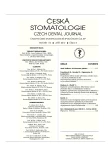Cholesterol as an Aetiological Factor of Persistent Asymptomatic Apical Periodontitis
Authors:
J. Kováč
Authors‘ workplace:
Bratislava, SR
; Klinika stomatológie a maxilofaciálnej chirurgie LF UK a OÚSA
Published in:
Česká stomatologie / Praktické zubní lékařství, ročník 112, 2012, 5, s. 135-142
Category:
Review Article
Overview
Objectives:
Microbial colonization of the root canal system has been shown to be the prime cause of apical periodontitis. Therefore, the main goal of the endodontic treatment is to eliminate microorganisms present in the root canal system, remove disintegrated pulp tissues that could serve as substrate for microbial growth, and fill the endodontic space to preclude bacterial recolonization, so as to prevent apical periodontitis or allow its healing. Microbial infection persisting in the root canal and/or periapex is also considered to be the most significant factor that affects the outcome of endodontic therapy. However, there are also other biological factors that lead to asymptomatic radiolucencies persisting after root canal treatment, such as extraradicular infection, generally in the form of periapical actinomycosis; extruded root canal filling or other exogenous materials that cause a foreign body reaction; accumulation of endogenous cholesterol crystals that irritate periapical tissues; cystic lesions, and scar tissue healing of the lesion.
Conclusion:
The purpose of this article is to review the causative factors of non-resolving periapical lesions – persistent apical periodontitis that are radiographically seen after endodontic treatment of devitalized teeth as asymptomatic radiolucencies – specifically the presence of cholesterol crystals in these lesions.
Key words:
cholesterol crystals – persistent apical radiolucency – non-healing apical periodontitis – asymptomatic apical periodontitis – foreign body reaction
Sources
1. García, C. C., Sempere, F. V., Diago, M. P., Bowen, E. M.: The post-endodontic periapical lesion: Histologic and etiopathogenic aspects. Med. Oral. Patol. Oral. Cir. Bucal., roč. 12, 2007, č. 8, s. E585–E590.
2. Halčák, L., a kol.: Lekárska biochémia I. Bratislava, Polygrafické stredisko UK, 2001, 244 s.
3. Kováč, J.: Reakcia apikálneho parodontu na obsah koreňového kanálika zuba. Doktorandská dizertačná práca. Lekárska fakulta Univerzity Komenského, Bratislava 2010, 151 s.
4. Kováč, J., Kováč, D.: Gutaperča v zubnom lekárstve. Čes. Stomat. Prakt. zub. Lék., roč. 111/59, 2011, č. 2, s. 23–28.
5. Kováč, J., Kováč, D.: Histopatológia a etiopatogenéza chronickej apikálnej parodontitídy – periapikálnych granulómov. Epidemiol. Mikrobiol. Imunol., roč. 60, 2011, č. 2, s. 77–86.
6. Kováč, J., Kováč, D.: Príčiny pretrvávajúcej apikálnej parodontitídy pri endodonticky ošetrených devitálnych zuboch. Lek. Obz., roč. 60, 2011, č. 7-8, s. 342–346.
7. Nair, P. N. R.: Apical periodontitis: a dynamic encounter between root canal infection and host response. Periodontology 2000, roč. 13, 1997, s. 121–148.
8. Nair, P. N. R.: Cholesterol as an aetiological agent in endodontic failures – a review. Aust. Endod. J., roč. 25, 1999, č. 1, s. 19–26.
9. Nair, P. N. R.: Non-microbial etiology: foreign body reaction maintaining post-treatment apical periodontitis. Endod. Top., roč. 6, 2003, č. 1, s. 114–134.
10. Nair, P. N. R.: On the causes of persistent apical periodontitis: a review. Int. Endod. J., roč. 39, 2006, č. 4, s. 249–281.
11. Nair, P. N. R.: Pathogenesis of apical periodontitis and the causes of endodontic failures. Crit. Rev. Oral. Biol. Med., roč. 15, 2004, č. 6, s. 348–381.
12. Nair, P. N. R., Sjögren, U., Krey, G., Sundqvist, G.: Therapy-resistant foreign body giant cell granuloma at the periapex of a root-filled human tooth. J. Endod., roč. 16, 1990, č. 12, s. 589–595.
13. Nair, P. N. R., Sjögren, U., Schumacher, E., Sundqvist, G.: Radicular cyst affecting a root-filled human tooth: a long-term post-treatment follow-up. Int. Endod. J., roč. 26, 1993, č. 4, s. 225–233.
14. Nair, P. N. R., Sjögren, U., Sundqvist, G.: Cholesterol crystals as an etiological factor in non-resolving chronic inflammation: an experimental study in guinea pigs. Eur. J. Oral. Sci., roč. 106, 1998, č. 2, s. 644–650.
15. Ricucci, D., Siqueira Jr., J. F., Bate, A. L., Pitt Ford, T. R.: Histologic investigation of root canal-treated teeth with apical periodontitis: a retrospective study from twenty-four patients. J. Endod., roč. 35, 2009, č. 4, s. 493–502.
16. Siqueira Jr., J. F.: Aetiology of root canal treatment failure: why well-treated teeth can fail. Int. Endod. J., roč. 34, 2001, č. 1, s. 1–10.
17. Zaviačič, M., a kol.: Kompendium patológie – 1. diel. Všeobecná patológia a onkopatológia. 3. preprac. vyd. Bratislava, Univerzita Komenského, 2002, 374 s.
Labels
Maxillofacial surgery Orthodontics Dental medicineArticle was published in
Czech Dental Journal

2012 Issue 5
Most read in this issue
- Papillary Cystadenoma Lymphomatosum (Warthin’s Tumour) of Parotic Salivary Glands with Multifocal Manifestation
- Tooth agenesis review
- Conservative Treatment of Temporomandibular Joint Disorders
- Cholesterol as an Aetiological Factor of Persistent Asymptomatic Apical Periodontitis
